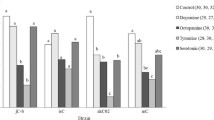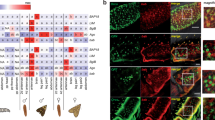Abstract
The genetic basis of the duration and incidence of male wing fanning to pheromone in the pink bollworm moth,Pectinophora gossypiella (Saunders), was examined by artificial selection. Using a still-air bioassay, males from a laboratory colony were selected for increased duration of wing fanning when exposed to a 65∶35 blend of (Z,E)- and (Z,Z)-7,11-hexadecadienyl acetates. The mean (±SE) duration of wing fanning in the selected line increased from 5.4±1.4 to 17.4±2.7 s after six generations. The increase in wing fanning duration was the result of an increase in response duration among responders and not the percentage of males that responded. Realized heritability of wing-fanning duration was 0.16±0.02. The amount and ratio of pheromone produced by females in the male-selected line did not change.
Similar content being viewed by others
References
Alexander, R. D. (1962). Evolutionary change in cricket acoustical communication.Evolution 16:443–467.
Bierl, B. A., Beroza, M., Staten, R. T., Sonnet, P. E. and Adler, V. E. (1974). The pink bollworm sex attractant.J. Econ. Entomol. 67:211–216.
Cardé, R. T. (1976). Utilization of pheromones in the population management of moth pests.Environ. Health Perspect. 14:133–144.
Cardé, R. T. (1981). Disruption of long-distance pheromone communication in the oriental fruit moth: Camouflaging the natural aerial trails from females? In Mitchell, E. R. (ed.),Management of Insect Pests with Semiochemicals: Concepts and Practice, Plenum Press, New York, pp. 385–401.
Collins, R. D., and Cardé, R. T. (1985). Variation in and heritability of aspects of pheromone production in the pink bollworm moth,Pectinophora gossypiella (Lepidoptera: Gelechiidae).Ann. Entomol. Soc. Am. 78:229–234.
Collins, R. D., and Cardé, R. T. (1989a). Heritable variation in pheromone response of the pink bollworm,Pectinophora gossypiella (Lepidoptera: Gelechiidae).J. Chem. Ecol. 15:2647–2659.
Collins, R. D., and Cardé, R. T. (1989b). Selection for altered pheromone-component ratios in the pink bollworm moth,Pectinophora gossypiella (Lepidoptera: Gelechiidae).J. Insect. Behav. 2:609–621.
Collins, R. D., and Cardé, R. T. (1989c). Wing fanning as a measure of pheromone response in the male pink bollworm,Pectinophora gossypiella (Lepidoptera: Gelechiidae).J. Chem. Ecol. 15:2635–2645.
Collins, R. D., Rosenblum, S. L., and Cardé, R. T. (1990). Selection for increased pheromone titre in the pink bollworm moth,Pectinophora gossypiella (Lepidoptera: Gelechiidae).Physiol. Entomol. (in press).
Croft, B. A., and Hoyt, S. C. (1978). Considerations for the use of pyrethroid insecticides for deciduous fruit pest control in the U.S.A.Environ. Entomol. 7:627–630.
Doane, C. C., and Brooks, T. W. (1981). Research and development of pheromones for insect control with emphasis on the pink bollworm. In Mitchell, E. R. (ed.),Management of Insect Pests with Semiochemicals, Plenum Press, New York, pp. 285–303.
Elkinton, J. S., Schal, C., Ono, T., and Cardé, R. T. (1987). Pheromone puff trajectory and upwind flight of male gypsy moths in a forest.Physiol. Entomol. 12:399–406.
Falconer, D. S. (1981).Introduction to Quantitative Genetics, Longman, London.
Flint, H. M., Smith, R. L., Forey, D. E., and Horn, B. R. (1977). Pink bollworm: Response of males to (Z,Z-) and (Z,E-) isomers of gossyplure.Environ. Entomol. 6:274–275.
Flint, H. M., Smith, R. L., Noble, J. M., and Shaw, D. (1978). Pink bollworm: response of released APHIS strain and native moths to ratios ofZ,Z andZ,E isomers of gossyplure in the field.J. Econ. Entomol. 71:664–666.
Graham, H. M., Glick, P. A., and Martin, D. F. (1964). Nocturnal activity of adults of six lepidopterous pests of cotton as indicated by light-trap collections.Ann. Entomol. Soc. Am. 57:328–332.
Hummel, H. E., Gaston, L. K., Shorey, H. H., Kaae, R. S., Byrne, K. J., and Silverstein, R. M. (1973). Clarification of the chemical status of the pink bollworm sex pheromone.Science 181:873–875.
Kyriacou, C. P., and Hall, J. C. (1986). Interspecific genetic control of courtship song production and reception inDrosophilia.Science 232:494–497.
Sokal, R. S., and Rohlf, F. J. (1981).Biometry: The Principles and Practices of Statistics in Biological Research, 2nd ed., W. H. Freeman, New York.
Van Steenwyk, R. A., Ballmer, G. R., and Reynolds, H. T. (1978). Nocturnal trap catches of the pink bollworm.Ann. Entomol. Soc. Am. 71:354–356.
Author information
Authors and Affiliations
Additional information
This research was supported in part by NSF Grant PCM-8309398 and a University of Massachusetts Biomedical Research Grant.
Rights and permissions
About this article
Cite this article
Collins, R.D., Cardé, R.T. Selection for increased pheromone response in the male pink bollworm,Pectinophora gossypiella (lepidoptera: Gelechiidae). Behav Genet 20, 325–331 (1990). https://doi.org/10.1007/BF01067799
Received:
Accepted:
Issue Date:
DOI: https://doi.org/10.1007/BF01067799




